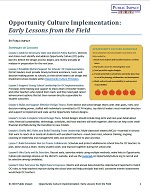 Early Lessons from the Field
Early Lessons from the Field
Opportunity Culture® models have been operating in pioneering schools since the 2013–14 school year. What early lessons do the schools offer in implementing these models to put excellent teachers in charge of all students’ learning, for more pay, and provide all teachers with frequent, on-the-job support and development? In a new brief, Opportunity Culture® Implementation: Early Lessons from the Field, we share the lessons that Public Impact® and our partners have learned from our work with these schools in their early stages of Opportunity Culture® implementation. It summarizes the nine overarching lessons listed below, offers our solutions for assistance providers, schools, and districts, and gives examples of actions that Public Impact®, our partners, and some schools and districts have taken.
We are using these lessons to improve our free implementation tools and materials on OpportunityCulture.org, along with the services that Public Impact®, our partners, district change-management staff, and independent technical assistance providers offer to guide district leaders and schools.
Lesson 1: Address Necessary State and District Policy Barriers. Districts and states must identify and address Opportunity Culture® (OC) policy barriers before the design process begins, and review annually at midyear in preparation for the next year.
Lesson 2: Establish District Support for Schools’ OC Implementation. District leaders must provide timely technical assistance, tools, decision-making power, and transitional support for small, temporary financial shortfalls for school models within Opportunity Culture® Principles.
Lesson 3: Support Strong School Leadership for OC Implementation. Principals need training and support to lead a team of teacher-leaders and other teachers who extend their reach, and they need paid career advancement options that let them remain directly responsible for student outcomes.
Lesson 4: Build and Support Effective Design Teams. Form district and school design teams with clear goals, roles, and decision-making power, staffed with individuals committed to OC Principles; top district leaders must maintain direction and support to implement and scale up the Opportunity Culture® designs.
Lesson 5: Create Complete School Design Plans. School designs should include long-term and next-year detail about roles, financial sustainability, technology, schedules, and how teachers will work together.
Lesson 6: Clarify MCL Roles and Build Teaching Team Leadership. Multi-classroom leaders (MCLs)—essential in schools that want to reach all or nearly all students with excellent teachers—need clear roles, advance training, ongoing coaching in leadership and management skills, and protected time to plan and lead.
Lesson 7: Build Schedules that Let Teams Collaborate. Schedule and protect additional in-school time for OC teachers to plan, alone and as a team; review student work; and improve together during the school year.
Lesson 8: Hire Early and Be Selective. Recruit early, advertise widely using multiple methods, make links to Opportunity Culture® job openings obvious on the district’s website, and use the materials on OpportunityCulture.org to recruit and be selective among candidates.
Lesson 9: Give Everyone the Right Data to Improve. Interim and annual data should be collected and reported to match OC roles, to help teachers improve during the school year and help principals lead well; consistent interim assessments would help OC teachers.
Read more about implementation lessons here.
